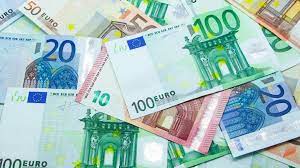The euro took a sharp dive on Friday, erasing earlier gains after U.S. President Donald Trump announced plans to slap a hefty 50% tariff on European Union imports starting June 1, 2025.
The provocative move, detailed in a post on Trump’s Truth Social platform, has reignited investor concerns about the ripple effects of escalating trade tensions on the global economy.
The announcement marks a dramatic escalation in Trump’s trade rhetoric, shifting market focus from U.S. fiscal woes to the specter of a renewed trade war.
In his post, Trump lambasted the EU, calling it “very difficult to deal with” and claiming that trade negotiations were “going nowhere.” He proposed a blanket 50% tariff on EU goods, with an exemption for products manufactured in the United States, a policy that echoes his earlier threat to impose a 25% tariff on iPhones not made domestically.
The euro, which had climbed nearly 0.8% earlier in the day following Trump’s Apple tariff threat, reversed course to close up just 0.45% at $1.1336.
The dollar, meanwhile, trimmed some losses against the Japanese yen and British pound but remained on track for its first weekly decline against a basket of currencies in five weeks.
The yen, a traditional safe-haven asset, strengthened nearly 1% to 142.52 against the dollar, buoyed by Japan’s latest inflation data showing core inflation rising at its fastest pace in over two years.
The Swiss franc also rallied, gaining 0.7% to 0.8225 against the dollar, as investors sought refuge from the uncertainty sparked by Trump’s tariff plans.
The tariff announcement has also put pressure on other major economies. In Japan, the yen’s strength was bolstered by data showing core inflation accelerating to its highest annual rate in over two years, driven by persistent food price pressures.
This has raised expectations of another interest rate hike by the Bank of Japan (BOJ) before year-end, even as the central bank navigates economic headwinds from Trump’s proposed tariffs. Super-long Japanese government bonds, which hit record highs earlier this week, held steady on Friday.
The EU, a key U.S. trading partner, now faces the prospect of significant economic disruption if Trump’s tariffs are implemented. The proposed 50% duties could hit European exporters hard, particularly in industries like automotive, agriculture, and luxury goods, which rely heavily on the U.S. market.
Analysts warn that retaliatory measures from the EU could further escalate tensions, potentially derailing the fragile global trade recovery following the U.S.-China tariff truce earlier this month.
Trump’s tariff threats mark a return to his aggressive trade policies, which defined much of his first term. The move has drawn sharp criticism from economists, who argue that such high tariffs could disrupt supply chains, increase consumer prices, and dampen global growth.
The timing is particularly precarious, as markets remain on edge over the U.S.’s fiscal trajectory and the uncertainty surrounding the Senate’s handling of Trump’s tax bill.
investors are bracing for heightened volatility. “Trump’s tariff rhetoric is a wake-up call for markets that had briefly shifted focus to fiscal concerns,” said Cincotta. “The combination of trade uncertainty and a growing debt burden is a toxic mix for investor confidence.”
WHAT YOU SHOULD KNOW
As the June 1 deadline looms, the world watches closely to see whether Trump’s tariff threats materialize or serve as a negotiating tactic in ongoing trade talks with the EU. For the euro and global markets, the next few weeks promise to be a turbulent ride.
ALSO READ TOP STORIES FROM VERILY NEWS


















